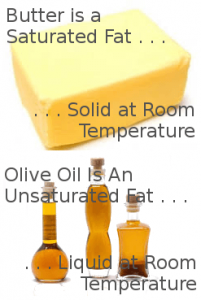Fat and weight loss
Fats come in two forms, saturated, which is solid at room temperature and unsaturated, which is liquid at room temperature, and should form about twenty-five percent (but no more than thirty percent) of total calorie intake in a well balanced weight loss diet plan.
temperature and unsaturated, which is liquid at room temperature, and should form about twenty-five percent (but no more than thirty percent) of total calorie intake in a well balanced weight loss diet plan.
Saturated fat includes butter, lard, and fat derived from animal products. Unsaturated fat, including olive oil, corn oils, sesame oil, and oils derived from plants.
Diet – Fats: Do We Need them?
To the misinformed people who believe that dispensing with fat in their diet will speed up their weight loss and reduce their risk of heart attacks or stroke, think again!
Not only is fat an essential nutrient in supplying energy, it complements other forms of nutrients and we cannot survive on a diet that is completely fat free, if such a diet exists.
One gram of fat contains nine calories, so a person on a three thousand calorie maintainance level would need to consume around eighty grams of fat daily which would account for seven hundred and twenty calories (80×9=720).Ideally, all of your daily diet fat intake should come from good fats, although a very small amount, around one or two percent, of saturated fat is permissible. I have read that one third of your daily fat intake can come from saturated fats, but I personally would stick with unsaturated fat whenever possible.
Where Do Fats Come From?
Fat is obtained from two sources: Animal fat and vegetable fat. Animal fat is derived mainly from Meat; Poultry; Butter; Cheese; and Milk. Vegetable fat comes mainly from various oils, such as Peanut Oil; Olive Oil; and Corn Seed Oil to name a few.
These sources are categorized into four types of fat: saturated and trans, both commonly known as bad fat; and polyunsaturated and monounsaturated, both commonly known as good fat.
There are differing opinions as to the use of coconut oil as part of a weight loss diet. Some advocate that it should be avoided, claiming coconut oil and palm oil are both heavy in saturated fat. Others maintain, although it is a saturated fat, it is a harmless oil, and has been proven not to cause heart disease, and actually helps fight cardiovascular disease.
The pro-coconut oil faction also claim that it actually promotes weight loss by burning as fuel for the body instead of storing as fat, and is the best oil you can use in your diet, particularly when cooking with high temperatures.
Why Are Saturated And Trans Fats Known As Bad Fats?
Over time, high intake of saturated fats, as nutritionists will tell you, can lead to an increase in your bad cholesterol level and lower your good cholesterol levels increasing the risk of strokes and heart attacks and is also linked to many types of cancer.
Foods which contain the most amounts of saturated fats can be found in Meat; Meat Products; Poultry that hasn’t been skinned; Milk, unless skimmed; Cheese, unless fat free; Butter and Lard.
Also avoid too high, or better still, no consumption of fast foods, or junk foods as they are commonly known. Foods such as Cakes; Biscuits; Pastries; and Potato Chips (Crisps in the UK) should also be avoided, as most processed foods are also high in saturated fats.
Trans fats, also known as partially hydrogenated oils, and may be derived from poly or mono unsaturated fats, are synthetically made and do not occur naturally. They should be avoided as they are not conducive to good health and are certainly not needed in the essential nutrients that support human life.
Some foods which are most likely to contain trans fats are: French Fries; most Fried Foods; and any number of Baked Foods such as Biscuits, Crackers, Pizza Dough, Pastries and Pies.
Why Are Polyunsaturated And
Monounsaturated Fats Known As Good Fats?
Most nutritionists will tell you that both poly and mono unsaturated fats are vital in maintaining good health, although there are differing opinions among health experts as to which is the healthiest.
The majority tend to lean towards mono-unsaturated fat as the healthiest, although polyunsaturated fat contains essential fatty acids such as linoleic acid (omega-6s) and alpha-linoleic acid (omega-3s), which the body cannot produce itself, and may protect you against heart disease, some types of cancer, immune system deficiencies, arthritis and obesity.
Both fats are a rich source of vitamin E, which is an excellent antioxidant Superfoods: Antioxidants and can protect you from heart disease and aging and encourage skin healing and reduce scarring.
Polyunsaturated fats can also reduce the levels of bad cholesterol but may also reduce the levels of good cholesterol, whereas monounsaturated fat can reduce the level of bad cholesterol while maintaining, or possibly increasing, the level of good cholesterol.
Some of the main sources of polyunsaturated fats are found in oily fish such as Sardines; Mackerel; Trout; Salmon; and Herring. Safflower Oil; Corn Oil; Rape Seed Oil; and Sunflower Oil are also good sources of polyunsaturated fats.
Some of the many sources of monounsaturated fats include Nuts: Peanuts, Walnuts, Almonds, and Hazelnuts; Avocado; Canola and Olive Oils; Rape Seed Oil; and Pumpkin Seeds.
When using oil in cooking, monounsaturated oils are preferred, especially extra virgin olive oil, as they remain stable at high temperatures and do not revert to hydrogenated or saturated fats.
I hope Diet – Fat has given you an insight into the different type of fats and why they are essential to maintain good health and a healthy balanced diet, weight loss or otherwise.
